
The Space Shuttle is a retired, partially reusable low Earth orbital spacecraft system operated from 1981 to 2011 by the U.S. National Aeronautics and Space Administration (NASA) as part of the Space Shuttle program. Its official program name was Space Transportation System (STS), taken from a 1969 plan for a system of reusable spacecraft where it was the only item funded for development.

Space Shuttle Discovery is a retired American spacecraft. The spaceplane was one of the orbiters from NASA's Space Shuttle program and the third of five fully operational orbiters to be built. Its first mission, STS-41-D, flew from August 30 to September 5, 1984. Over 27 years of service it launched and landed 39 times, aggregating more spaceflights than any other spacecraft to date. The Space Shuttle launch vehicle had three main components: the Space Shuttle orbiter, a single-use central fuel tank, and two reusable solid rocket boosters. Nearly 25,000 heat-resistant tiles cover the orbiter to protect it from high temperatures on re-entry.
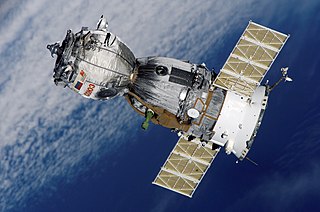
A spacecraft is a vehicle that is designed to fly in outer space and operate there. Spacecraft are used for a variety of purposes, including communications, Earth observation, meteorology, navigation, space colonization, planetary exploration, and transportation of humans and cargo. All spacecraft except single-stage-to-orbit vehicles cannot get into space on their own, and require a launch vehicle.

The Space Shuttle program was the fourth human spaceflight program carried out by the U.S. National Aeronautics and Space Administration (NASA), which accomplished routine transportation for Earth-to-orbit crew and cargo from 1981 to 2011. Its official name, Space Transportation System (STS), was taken from a 1969 plan for a system of reusable spacecraft of which it was the only item funded for development. It flew 135 missions and carried 355 astronauts from 16 countries, many on multiple trips.

The Hubble Space Telescope is a space telescope that was launched into low Earth orbit in 1990 and remains in operation. It was not the first space telescope, but it is one of the largest and most versatile, renowned as a vital research tool and as a public relations boon for astronomy. The Hubble telescope is named after astronomer Edwin Hubble and is one of NASA's Great Observatories. The Space Telescope Science Institute (STScI) selects Hubble's targets and processes the resulting data, while the Goddard Space Flight Center (GSFC) controls the spacecraft.
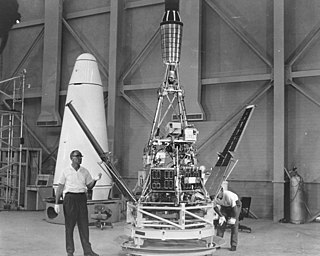
Ranger 1 was a prototype spacecraft launched as part of the Ranger program of uncrewed space missions. Its primary mission was to test the performance of those functions and parts necessary for carrying out subsequent lunar and planetary missions; a secondary objective was to study the nature of particles and fields in the space environment. Due to a launch vehicle malfunction, the spacecraft could reach only Low Earth orbit, rather than the high Earth orbit that had been planned, and was only able to complete part of its mission.
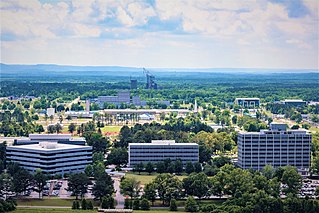
The George C. Marshall Space Flight Center (MSFC), located in Redstone Arsenal, Alabama, is the U.S. government's civilian rocketry and spacecraft propulsion research center. As the largest NASA center, MSFC's first mission was developing the Saturn launch vehicles for the Apollo program. Marshall has been the lead center for the Space Shuttle main propulsion and external tank; payloads and related crew training; International Space Station (ISS) design and assembly; computers, networks, and information management; and the Space Launch System. Located on the Redstone Arsenal near Huntsville, MSFC is named in honor of General of the Army George C. Marshall.
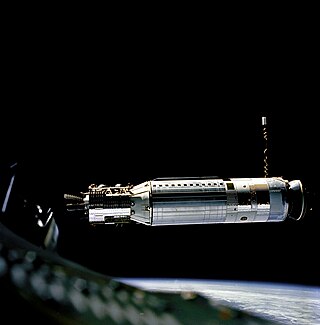
The RM-81 Agena was an American rocket upper stage and satellite bus which was developed by Lockheed Corporation initially for the canceled WS-117L reconnaissance satellite program. Following the division of WS-117L into SAMOS and Corona for image intelligence, and MIDAS for early warning, the Agena was later used as an upper stage, and an integrated component, for several programs, including Corona reconnaissance satellites and the Agena Target Vehicle used to demonstrate rendezvous and docking during Project Gemini. It was used as an upper stage on the Atlas, Thor, Thorad and Titan IIIB rockets, and considered for others including the Space Shuttle and Atlas V. A total of 365 Agena rockets were launched between February 28, 1959 and February 1987. Only 33 Agenas carried NASA payloads and the vast majority were for DoD programs.
The RAD6000 radiation-hardened single-board computer, based on the IBM RISC Single Chip CPU, was manufactured by IBM Federal Systems. IBM Federal Systems was sold to Loral, and by way of acquisition, ended up with Lockheed Martin and is currently a part of BAE Systems Electronic Systems. RAD6000 is mainly known as the onboard computer of numerous NASA spacecraft.

STS-95 was a Space Shuttle mission launched from Kennedy Space Center, Florida on 29 October 1998, using the orbiter Discovery. It was the 25th flight of Discovery and the 92nd mission flown since the start of the Space Shuttle program in April 1981. It was a highly publicized mission due to former Project Mercury astronaut and United States Senator John H. Glenn Jr.'s return to space for his second space flight. At age 77, Glenn became the oldest person to go into space, a record that remained unbroken for 23 years until 82-year-old Wally Funk flew on a suborbital flight on Blue Origin NS-16, launching on 20 July 2021, which in turn was broken by William Shatner at age 90 on 13 October 2021. Glenn, however, remains the oldest person to reach Earth orbit. This mission is also noted for inaugurating ATSC HDTV broadcasting in the U.S., with live coast-to-coast coverage of the launch. In another first, Pedro Duque became the first Spaniard in space.

STS-103, the 96th launch of the Space Shuttle and the 27th launch of Space Shuttle Discovery, was a Hubble Space Telescope servicing mission. It launched from Kennedy Space Center, Florida, on 19 December 1999 and returned on 27 December 1999 and was the last Shuttle mission of the 1990s. It was the only mission to span through Christmas after being delayed by 13 days for technical and weather reasons.

John Mace Grunsfeld is an American physicist and a former NASA astronaut. He is a veteran of five Space Shuttle flights and has served as NASA Chief Scientist. His academic background includes research in high energy astrophysics, cosmic ray physics and the emerging field of exoplanet studies with specific interest in future astronomical instrumentation. After retiring from NASA in 2009, he served as the deputy director of the Space Telescope Science Institute in Baltimore, Maryland. In January 2012, he returned to NASA and served as associate administrator of NASA's Science Mission Directorate (SMD). Grunsfeld announced his retirement from NASA in April 2016.

Project Gemini was the second United States human spaceflight program to fly. Conducted after the first American manned space program, Project Mercury, while the Apollo program was still in early development, Gemini was conceived in 1961 and concluded in 1966. The Gemini spacecraft carried a two-astronaut crew. Ten Gemini crews and 16 individual astronauts flew low Earth orbit (LEO) missions during 1965 and 1966.
Lockheed Martin Space is one of the four major business divisions of Lockheed Martin. It has its headquarters in Littleton, Colorado, with additional sites in Valley Forge, Pennsylvania; Sunnyvale, California; Santa Cruz, California; Huntsville, Alabama; and elsewhere in the United States and United Kingdom. The division currently employs about 20,000 people, and its most notable products are commercial and military satellites, space probes, missile defense systems, NASA's Orion spacecraft, and the Space Shuttle external tank.
The RAD750 is a radiation-hardened single-board computer manufactured by BAE Systems Electronics, Intelligence & Support. The successor of the RAD6000, the RAD750 is for use in high-radiation environments experienced on board satellites and spacecraft. The RAD750 was released in 2001, with the first units launched into space in 2005.

STS-125, or HST-SM4, was the fifth and final Space Shuttle mission to the Hubble Space Telescope (HST). The launch of the Space Shuttle Atlantis occurred on May 11, 2009, at 2:01 pm EDT. Landing occurred on May 24 at 11:39 am EDT, with the mission lasting a total of just under 13 days.
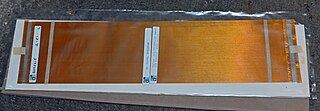
Plated-wire memory is a variation of magnetic-core memory developed by Bell Laboratories in 1957. Its primary advantage was that it could be assembled by machine, which potentially led to lower prices than magnetic core, which was almost always assembled by hand.
An orbital replacement unit or orbital replaceable unit is a modular component of spacecraft that can be replaced upon failure either by robot or by extravehicular activity. The Hubble Space Telescope (HST) was designed with 70 such parts, including scientific instruments and limited-life items such as batteries.
The NASA Standard Spacecraft Computer-1 (NSSC-1) is a computer developed as a standard component for the MultiMission Modular Spacecraft at the Goddard Space Flight Center (GSFC) in 1974. The basic spacecraft was built of standardized components and modules, for cost reduction. The computer had 18 bit wide core memory or plated wire memory; up to 64 k. 18 bits was chosen because it gave more accuracy (x4) for data over a 16 bit machine. Floating point arithmetic was not supported.

Docking and berthing of spacecraft is the joining of two space vehicles. This connection can be temporary, or partially permanent such as for space station modules.















